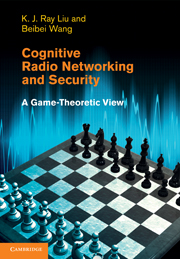Book contents
- Frontmatter
- Contents
- Preface
- Part I Cognitive radio communications and cooperation
- 1 Introduction to cognitive radios
- 2 Game theory for cognitive radio networks
- 3 Markov models for dynamic spectrum allocation
- 4 Repeated open spectrum sharing games
- 5 Pricing games for dynamic spectrum allocation
- 6 A multi-winner cognitive spectrum auction game
- 7 Evolutionary cooperative spectrum sensing games
- 8 Anti-jamming stochastic games
- 9 Opportunistic multiple access for cognitive networks
- Part II Resource awareness and learning
- Part III Securing mechanism and strategies
- References
- Index
1 - Introduction to cognitive radios
from Part I - Cognitive radio communications and cooperation
Published online by Cambridge University Press: 06 December 2010
- Frontmatter
- Contents
- Preface
- Part I Cognitive radio communications and cooperation
- 1 Introduction to cognitive radios
- 2 Game theory for cognitive radio networks
- 3 Markov models for dynamic spectrum allocation
- 4 Repeated open spectrum sharing games
- 5 Pricing games for dynamic spectrum allocation
- 6 A multi-winner cognitive spectrum auction game
- 7 Evolutionary cooperative spectrum sensing games
- 8 Anti-jamming stochastic games
- 9 Opportunistic multiple access for cognitive networks
- Part II Resource awareness and learning
- Part III Securing mechanism and strategies
- References
- Index
Summary
With the rapid deployment of new wireless devices and applications, the last decade has witnessed a growing demand for wireless radio spectrum. However, the policy of fixed spectrum assignment produces a bottleneck for more efficient spectrum utilization, such that a great portion of the licensed spectrum is severely under-utilized. The inefficient usage of the limited spectrum resources has motivated the regulatory bodies to review their policy and start to seek innovative communication technology that can exploit the wireless spectrum in a more intelligent and flexible way. The concept of cognitive radio was proposed to address the issue of spectrum efficiency and has been receiving increasing attention in recent years, since it equips wireless users with the capability to optimally adapt their operating parameters according to the interactions with the surrounding radio environment. There have been many significant developments in the past few years concerning cognitive radios. In this chapter, the fundamentals of cognitive radio technology, including the architecture of a cognitive radio network and its applications, are introduced. The existing works on spectrum sensing are reviewed, and important issues in dynamic spectrum allocation and sharing are discussed in detail. Finally, an overview on implementation of cognitive radio platforms and standards for cognitive radio technology is provided.
Introduction
The usage of radio spectrum resources and the regulation of radio emissions are coordinated by national regulatory bodies such as the Federal Communications Commission (FCC).
Information
- Type
- Chapter
- Information
- Cognitive Radio Networking and SecurityA Game-Theoretic View, pp. 3 - 45Publisher: Cambridge University PressPrint publication year: 2010
